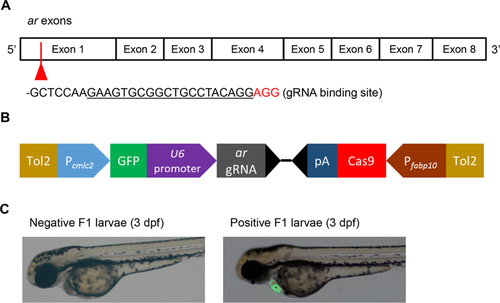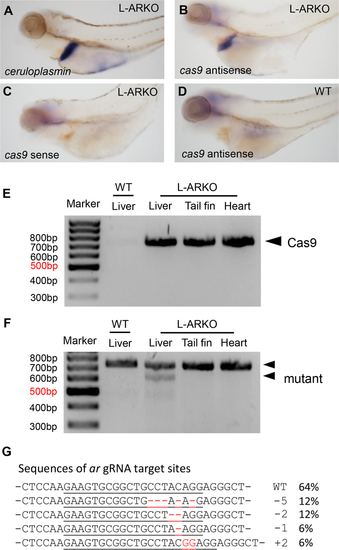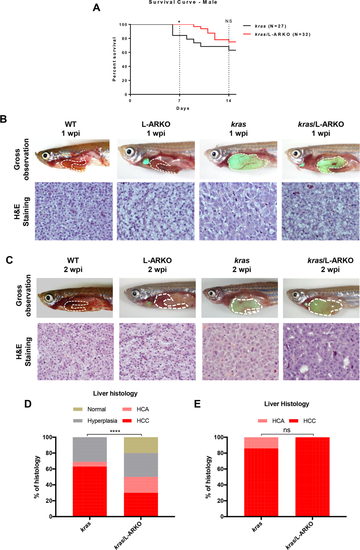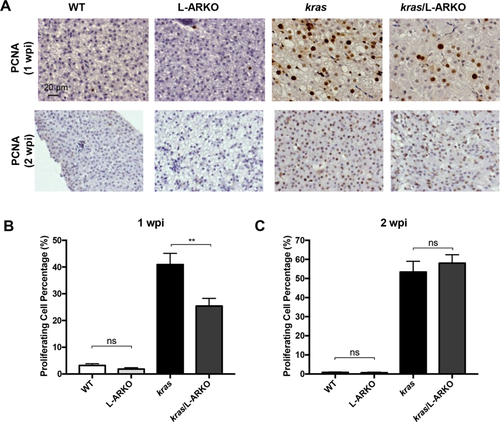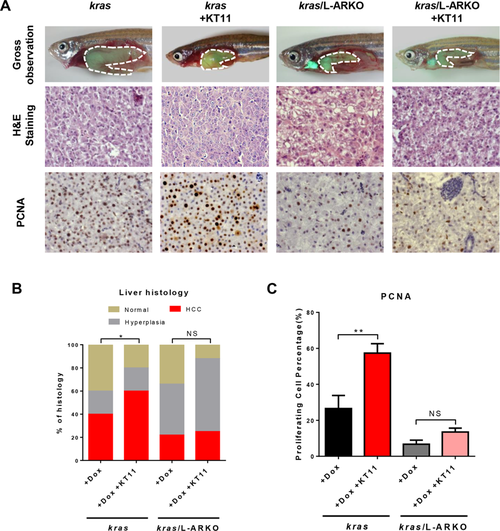- Title
-
Liver-specific androgen receptor knockout attenuates early liver tumor development in zebrafish
- Authors
- Li, H., Li, Y., Lu, J.W., Huo, X., Gong, Z.
- Source
- Full text @ Sci. Rep.
|
Structure of zebrafish ar gene and DNA construct for liver-specific knockout. (A) Schematic representation of eight arexons to cover the complete coding region. The sequence (underlined) and position of the ar gRNA target at the first exon are indicated. PAM sequence (Cas9 binding site) is in Red. (B) Schematic illustration of the liver-specific CRISPR construct. Tol2, Tol2 transposon; Pcmlc2: cmlc2 promoter; ar gRNA, ar guide RNA; pA: poly A signal; Pfabp10: fabp10a promoter. (C) The negative (left) and positive (right) F1 larvae from an L-ARKO founder transgenic zebrafish. The heart is marked with GFP expression as a screening marker.
|
|
Characterization of L-ARKO zebrafish. (A–D) Images of zebrafish larvae after whole mount in situ hybridization. 4 dpf L-ARKO larvae were subjected to whole mount in situ hybridization against the ceruloplasmin probe (A), cas9 antisense probe (B) and cas9 sense probe (C). 4 dpf WT larvae was examined against cas9 antisense probe (D). (E) PCR examination of cas9DNA in the liver, tail fin and heart of the F2 L-ARKO zebrafish. WT liver was used as a negative control. (F) T7E1 mutagenesis assay for the CRISPR target site in the ar gene in the WT zebrafish liver and F2 L-ARKO zebrafish liver, tail fin and heart. both WT and mutant ar bands are indicated with arrowheads. (G) Sequences of ar gRNA target sites. The target sites were amplified by PCR from liver DNA of an F2 L-ARKO fish and sequenced. The gRNA targeted sequence is underlined and the mutations in red. The type of mutation and frequency in percentage are indicated. All of the mutated sequences caused reading frame changes and premature termination codons.
|

ZFIN is incorporating published figure images and captions as part of an ongoing project. Figures from some publications have not yet been curated, or are not available for display because of copyright restrictions. |
|
Effects of liver-specific ar knockout on male kras zebrafish. (A) Kaplan-Meier survival curves of male kras and kras/L-ARKO zebrafish during 14-day Dox treatment. (B,C) Representative images of the gross observations (upper) and liver histology images (lower) from WT, L-ARKO, kras and kras/L-ARKO zebrafish after Dox induction for one week (B) or two week (C). Livers are outlined by a dashed line. (D,E) Quantitative analyses of histological phenotypes of liver sections from the 1-wpi (D) and 2-wpi (E) samples. HCA, hepatocellular adenoma; HCC, hepatocellular carcinoma. Statistical significance between the kras and kras/L-ARKO groups for the incidence of different tumor types: *p < 0.05; ****p < 0.0001; ns, no significant difference.
PHENOTYPE:
|
|
PCNA analyses of cell proliferation. (A) Representative images of PCNA staining of liver sections of WT, L-ARKO, kras and kras/L-ARKO zebrafish after Dox induction for one week (upper) or two week (lower). (B,C) Quantification of the cell proliferation in liver sections based on PCNA staining at 1 wpi (B) and 2 wpi (C). NS: not significant. Quantification of PCNA staining. Statistical significance: **p < 0.01; NS, not significant.
PHENOTYPE:
|
|
Lack of response to KT11 in kras/L-ARKO zebrafish during liver tumor progression. (A) Representative images of the gross observations (top), histology images (middle) and PCNA staining (bottom) from male kras and kras/L-ARKO zebrafish treated with Dox with or without KT11. Livers are outlined by a dashed line. (B) Quantitative analyses of histological phenotypes. (C) Quantification of liver cell proliferation based on PCNA staining. Statistical significance between the krasand kras/L-ARKO groups for the incidence of different tumor types: *p < 0.05; **p < 0.01; NS: not significant.
PHENOTYPE:
|

ZFIN is incorporating published figure images and captions as part of an ongoing project. Figures from some publications have not yet been curated, or are not available for display because of copyright restrictions. |

